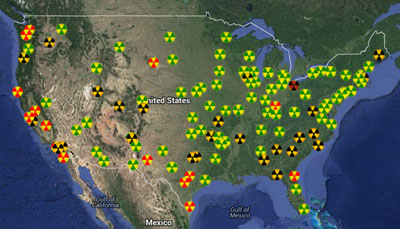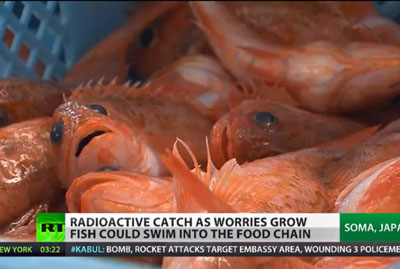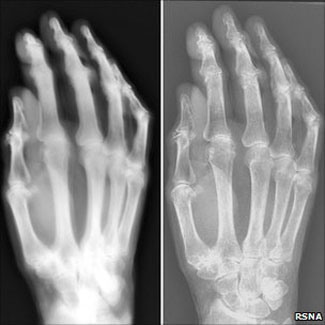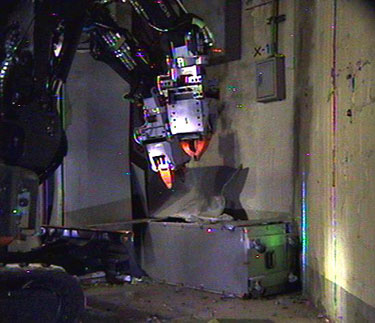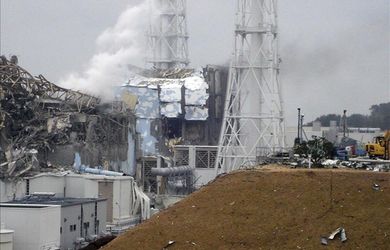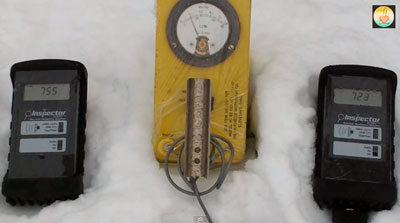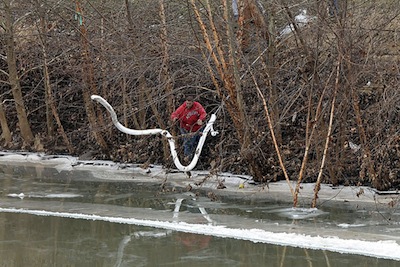
An Open Letter to Rob Brezsny Why All Need to be Concerned About Fukushima Radiation Hi Rob, In your newsletter this week, you said, "The scaremongering about Fukushima is grossly overblown," and provide a link to this site, in which the author assures us that it's OK to eat fish from the Pacific Ocean as long as they're not from Japan, and declares that radiation reaching the West Coast "will not be dangerous."
My problem with your statement is that as far as the public is concerned, you're saying don't worry, and you're not asking any questions at all. "Grossly overblown" does not even suggest you believe there might be a potential question. Why are you eager to spread the word that Fukushima is safe, or safe until proven dangerous? The problem does not have to be imminent disaster and the threat of relocation. Fukushima will proceed as a slow-motion crisis as the radiation gradually diffuses from the wreckage to the rest of the environment, concentrating in living creatures and working its way up the food chain. We have been covering this since the beginning -- it's a very serious situation, and it's not getting any better. There is no safe level of radiation exposure. Additionally, not everyone similarly situated gets the same exposure from an incident. Someone who eats one contaminated fish is going to have a problem, whereas someone who does not eat that fish won't have that particular problem. But there is no way to predict who will and who will not eat that one fish. Every fish is not being tested. "Don't eat fish from Japan" is ridiculous advice. Everyone who eats sushi eats fish from Japan, and it's obvious that some fish from Japan will be improperly classified and sold as non-Japanese product. Vegetarians are not immune. Many edible plants collect and concentrate radiation. This creates direct exposure and it moves up the food chain, ending up in dairy products and elsewhere.
Further, we all have a body burden of artificial radiation, from X-rays, radiotherapy, nuclear bomb testing that exposed the entire U.S. population, contaminated food from those tests that was distributed to the population, leaks from nuclear reactors, microwave ovens, irradiated foods, cellular telephones and cell towers. The entire West Coast is receiving radiation from the Manhattan Project dumps at Hanford, WA (via water table contamination), which then goes into the Columbia River and is transported to the Pacific and carried up and down the coast by currents. So we already have a lot of radiation we're dealing with; let's not forget increases in UV radiation exposure from ozone depletion. Therefore, whatever we get from Fukushima is adding to an already serious problem. Since when does adding any more make it OK? Since when, with the cancer rate hovering at around 50%? I do not need to present any evidence of any specific danger to be 'right'. I don't have to find a thousand contaminated fish or even one of them. My role is to educate people about the precautionary principle: what do you believe, and what do you do, in the face of missing or incomplete information, especially when there is a known point source, a known contamination crisis?
Blanket assurances don't stand up when there is a known deadly substance present, combined with insufficient data, a data blackout, a propaganda stream, conflicting data or facts plainly indicating a problem -- such as the established fact of all Pacific tuna being contaminated. In any environmental incidents I've ever covered or heard of, from Love Canal to 9/11 to Three Mile Island to SUNY New Paltz, the goal of officialdom is to minimize the perception of danger. The official position is always that something is safe until proven dangerous, and that anyone talking about the dangers is an alarmist. The official position is that a little is OK and it's fine if you only kill a few people (that's known as risk assessment). The popular position is usually "please, tell me it's safe." The precautionary principle says, you must do a worst-case analysis. However, if that were applied to nuclear power, it could not exist, because the worst case, which keeps happening, is so bad that society cannot actually deal with it. Fukushima cannot be cleaned up; this mess will torment hundreds of generations into the future, who will never know a moment of benefit from the electric power that was generated by the plant. You said: "Further evidence of sloppy research fed by emotion, not objective reporting: You say that Woods Hole is 'chopping wood for the nuclear industry'. Do you have even a shred of evidence for that claim?" In my experience, anyone who repeats knowing lies about a nuclear incident is doing the work of the nuclear industry, particularly if they bear scientific credentials. It does not matter if somewhere else they say they have their concerns; that merely creates the appearance of balance. Direct evidence of collusion is unnecessary. The fingerprints are in the point of view that supposedly objective scientists share with profit-driven, verging-on-psychotic proponents of nuclear power -- that all is well. Don't worry. I would feed that to my kid.
On their FAQ page, they leave out issues like biomagnification, as well as migratory fish and the known extent of the plume. They are taking a position used by polluters in the '60s and '70s that all you need to do is water down the toxins. Then through bioconcentration, various biota gather it right back up the food chain, where we humans reside at the very top. Any responsible scientist who wants to minimize the danger would say, "based on the data, we don't know," but the problem with that is there is a lot of data indicating a widespread, uncontained problem. The ethical position when there is missing or insufficient data is to tell people that they must take the time to inform themselves, and make their own decision once admitting that there are certain variables. But we do know enough to know there is a serious problem. The ethical position is not to declare the story overblown. Declaring a rumor overblown is one thing -- but you would have to specifically debunk THAT specific rumor to do so. Just because there were a series of Internet memes suggesting much worse dangers, some of which may have been exaggerated, does not make them wrong. They are based on something real -- Unit 3 is releasing steam, as confirmed by TEPCO; Unit 3 melted down; it has MOX plutonium fuel, and a lot of old assemblies in the spent fuel pool. You wrote: "I wonder if you think that Scientific American, National Geographic, and the National Academy of Sciences have joined Woods Hole in chopping wood and carrying water for the nuclear industry. They all have downplayed the dire doomsday prophecies circulating on Facebook, the Internet, and the Alex Jones radio show." This is not a case of either NAS or Alex Jones is right. That is a false dichotomy. As regards Scientific American, they have lied about dioxin before, along with many other 'reputable' journals repeating a series of fraudulent studies paid for by Monsanto. None of the secondary sources ever retracted their articles once the studies were proven fraudulent in later litigation.
Supposedly credible sources may downplay Alex Jones but that does not make him wrong. They may downplay the increased radiation levels that citizen monitors are reporting, and the leaking steam from the MOX wreckage at Unit 3. The thousands of tons of spent fuel on the Fukushima site present a real and ongoing threat, and if there is an expanded incident, it will be too late to prepare after the fact. Three hundred tons of radioactive water each and every day leaking into the Pacific Ocean is not a joke. It is nothing to minimize. All that radiation goes somewhere, and it's showing no signs of stopping. Fukushima is in the path of typhoons, earthquakes and tsunamis. There are thousands of tons of uranium and plutonium fuel on site. All of the buildings are in bad shape and most could not withstand another serious quake. There is nothing stable or safe about this situation, and it's so toxic that reporters cannot even get near it for more than an hour. Meanwhile, Japan has passed a law making it a crime to reveal or report on 'state secrets', including Fukushima. And to give one example how that works in the United States, MSNBC, the closest thing to real TV news, is co-owned by GE, the company that manufactured the reactors. So we cannot trust what is in the media. That is what we need to be talking about. With love,   Steam has recently been seen emanating from Unit 3 at the Fukushima Daiichi nuclear power plant. TEPCO, the Japanese utility in charge of operations at Fukushima Daiichi, confirmed that steam had been detected by surveillance cameras on Dec. 19, 24, 25 and 27. The steam appears to be coming from the fifth floor of the building, which was destroyed by an earthquake and tsunami on March 11, 2011. This is the first report of steam rising from that location since July 2013.
Unit 3 suffered severe damage from an explosion caused by a hydrogen buildup that breached the containment vessel. The reactor core of Unit 3, containing fuel comprising uranium and mixed uranium and plutonium (called MOX or mixed oxide nuclear fuel) went into full meltdown, likely melting into the earth below. Meanwhile, the spent fuel pool in Unit 3 contains 89 tons of highly dangerous MOX nuclear fuel, along with the 514 spent fuel assemblies. The fact that MOX fuel is stored on site at Fukushima Daiichi raises serious questions about the advantages of its use, and the risks associated with highly toxic and lethal plutonium. Explanations for the rising steam include the possibility that the melted core, now turned into corium, may have reached the groundwater beneath Unit 3, resulting in the release of vapor. Back in July, TEPCO hypothesized that rainwater falling upon stray fuel pellets and fuel rod fragments in the containment vessel could be causing the steam. There's also the chance that spontaneous fission could be occurring in the storage pool as water is heated and evaporated, leaving the fuel rods exposed and melting down, releasing radiation into the air. With 89 tons of MOX fuel in that pool, this release of radiation would contain highly volatile plutonium. There is no official data yet to determine what exactly is happening.
Two videos recorded in St. Louis, Missouri (available here and here) in December reveal elevated levels in snowfall. The tests show radiation levels three times higher than normal background radiation, using three different Geiger counters on two separate occasions. Officials have come forward dismissing the dangers associated with this spike in radiation, claiming there is no connection to Fukushima. Their position, as usual, is that there is no threat to public safety. Unfortunately, the real danger is unknown. Elevated levels of radiation in our air and water imply radionuclides in our food chain. Bioaccumulation, the buildup of these toxins in human tissues, cannot be measured with a Geiger counter. Each dose of radiation adds to what is already in the body. West Virginia Solvent Spill Endangers Thousands A dangerous chemical spill Thursday morning into the Elk River in West Virginia has contaminated the Kanawha Valley water supply, affecting about 300,000 in nine counties, prompting emergency declarations on both state and federal levels. It's uncertain how much of the chemical, 4-Methylcyclohexane Methanol, was leaked. The spill was upstream from one of the largest water processing facilities in its region. The chemical appears to be a chlorinated solvent that is deadly, that attacks the heart, lungs and kidneys, and can cause systemic damage. A state official claimed it was not toxic if swallowed.
The ban on using tap water for drinking, cooking, bathing or washing clothes prompted a run on water from supermarkets and convenience stores, which by nightfall were reportedly almost sold out. Schools and restaurants in the area were forced to close. "Right now, our priorities are our hospitals, nursing homes and schools," said Governor Earl Ray Tomblin. "I've been working with our National Guard and Office of Emergency Services in an effort to provide water and supplies through the county emergency services offices as quickly as possible." The leak, first reported on Thursday at 11:40 am EST, came from a 48,000-gallon tank at Freedom Industries coal treatment facility about a mile upriver from the West Virginia American Water Co. facility, said Tom Aluise, a spokesman for West Virginia’s Department of Environmental Protection. When the chemical reached the water treatment facility, it contaminated the tap water.  The Cannabis Edition, Part One This week we present the Cannabis edition of Planet Waves FM, opening up the topic of marijuana for the first time on Planet Waves. I also cover the Mercury-Venus conjunction, the Juno-Neptune conjunction and the cardinal grand cross. To unsubscribe, click here e Wiki | Friends | Editors | Contact Us Copyright © 2014 by Planet Waves, Inc. All Rights Reserved. Other copyrights may apply. Some images used under Fair Use or Share Alike attribution. |
